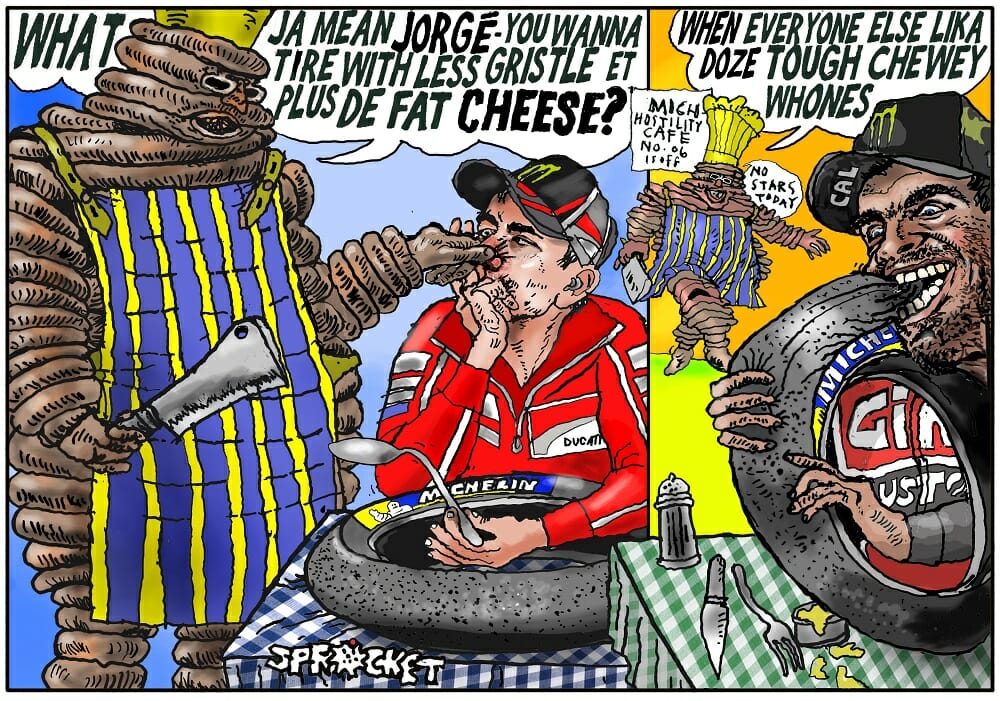Michael Scott | June 6, 2017
Round black things. Tires mean everything to modern racing. Just take the first five races of this year: the latest-generation Michelins have had a huge influence on results, and from race six onward will continue to do so—except in a different direction, after the first attempt at a new front tire was rejected by a vast majority of riders.
It had already played a big part. Defending champ Marc Marquez suffered two race crashes because of losing the front. This is not even to mention his practice spills—two identical ones at Le Mans alone.
Valentino Rossi had also complained: unable to get rid of that queasy front feeling with the new soft-carcass tire, although his Yamaha—or perhaps his decades of race-craft)—meant that he was getting better race finishes. (In his costly last-lap crash at Le Mans, by the way, he even took himself by surprise by losing the rear rather than the front.)
Both of these have a hard-braking style, shared with Cal Crutchlow, and indeed even forced on the Honda riders by its all-action short-chassis characteristics. Jorge Lorenzo, by contrast, is much smoother and more flowing. So it’s not that surprising to find he was one of three riders who voted against switching to the new tire at the pre-race forum at Le Mans, where 20 others voted for it.

In fact, the “new” tire is not so new. With a code name “70,” it was actually tried at the last round of last year at Valencia, and at post-race tests. From information gained there, Michelin then developed a 2017 tire, named “06,” with the same compounds but a softer construction.
This is the one that Marquez’s brutal braking causes to overheat, in turn causing him to fall off in Argentina and France.
The older “70” tire was actually shipped to round two in Argentina for further assessment, but a delay in delivery until after the meeting had already started lead the riders to vote against using it, to avoid complicating the situation further.
It was put away until joint tests after Jerez, and while the general opinion was that the differences were small, it was also favorable. But of course at this level of racing all the margins are minuscule. The difference between glowing success and dismal failure is measured in 10ths of seconds.
The vote means the stronger front will be back as the only tire of choice from round six at Mugello onwards. It will be interesting, especially Marquez and Rossi, to see what affect it has.
Because nothing is cut and dried, second Repsol Honda rider Pedrosa has been having a completely different kind of tire trouble. Being so light (official weight just 112 pounds) his problem is not over-heating but under-heating. He struggles to get the rubber to temperature, a particular problem in qualifying in cool conditions. At Le Mans he had to come through from 13th on the grid, impressively claiming a third podium in a row, thanks also to Rossi’s tumble.
The point being to underline just how marginal tires are, and how much difference a small change can make.
It is fair to say that most, maybe all, recent races have ultimately been decided by tires, all the more so since the arrival of Michelin last year. Their predecessors Bridgestone operated to more restrictive rules, offering a choice of just two different tires at each track. At the same time, they were made to the Japanese company’s philosophy, itself created by the production facility’s distance from the races. Their tires were necessarily broad-spectrum. But they still suited some bikes and some riders more than others.
Michelin took over last year, and this year the allocation was upped to a choice of three tires front and rear. It has introduced a new level of tire tactics, with riders having to make crucial choices.
In fact, there’s nothing very new about tires deciding races. Talk to an old-timer (in my case, 1970s GP winner Alan North), and even then when privateers were winning races and titles “there were guys getting special tires, and the rest of us stuck with what we had to buy.”
The heyday came in after the turn of the century, when Michelin, Dunlop and latterly Bridgestone were enjoying major tire wars, with rapid development even week by week. Or in the case of Rossi and a selected few others, day by day, with “silver bullet” tires made overnight in France and trucked in to the circuit in time for the race on Sunday.
There is something to be said for control tires. They still decide the racing, but without direct interference race by race, and with much less favoring of individual riders, adding a random element.
Though Marquez might disagree. CN